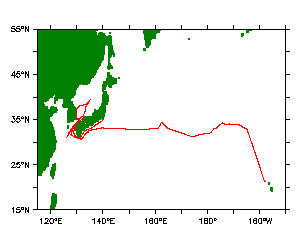|
|
 |
|
|
 |
Seven-stage multi-jet cascade impactors (Berner et al., 1979) sampling air at 55 � 5% RH were used to determine the sub- and supermicron concentrations of Cl-, NO3-, SO4=, methanesulfonate (MSA-), Na+, NH4+, K+, Mg+2, and Ca+2. The RH of the sampled air stream was measured a few inches upstream from the impactor. The 50% aerodynamic cutoff diameters, D50,aero, were 0.18, 0.31, 0.55, 1.1, 2.0, 4.1, and 10 um.
The impaction stage at the inlet of the impactor was coated with silicone grease to prevent the bounce of larger particles onto the downstream stages. Tedlar films were used as the collection substrate in the impaction stage and a Millipore Fluoropore filter (1.0-um pore size) was used for the backup filter. Films were cleaned in an ultrasonic bath in 10% H2O2 for 30 min, rinsed in distilled, deionized water, and dried in an NH3- and SO2-free glove box. Filters and films were wetted with 1 mL of spectral grade methanol. An additional 5 mLs of distilled deionized water were added to the solution and the substrates were extracted by sonicating for 30 min. The extracts were analyzed by ion chromatography [Quinn et al., 1998]. All handling of the substrates was done in the glove box. Blank levels were determined by loading an impactor with substrates but not drawing any air through it.
Non-sea salt sulfate concentrations were calculated from Na+ concentrations and the ratio of sulfate to sodium in seawater.
Concentrations are reported as ug/m3 at STP (25C and 1 atm).
Berner et al., Sci. Total Environ., 13, 245 - 261, 1979.
Quinn et al., J. Geophys. Res., 105, 6785 - 6805, 2000.
Information about the 7-stage OCEC sampling and data is available in a separate PDF document.
Seven-stage multi-jet cascade impactors (Berner et al., 1979) sampling air at 55 ± 5% RH were used to determine aerosol mass concentrations. The RH of the sampled air stream was measured a few inches upstream from the impactor. The 50% aerodynamic cutoff diameters, D50,aero, were 0.18, 0.31, 0.55,1.06, 2.02, 4.13,and 10.30 um.
The impaction stage at the inlet of the impactor was coated with silicone grease to prevent the bounce of larger particles onto the downstream stages. Tedlar films were used as the collection substrate in the impaction stage and a Millipore Fluoropore filter (1.0-um pore size) was used for the backup filter. Films were cleaned in an ultrasonic bath in 10% H2O2 for 30 min, rinsed in distilled, deionized water, and dried in an NH3- and SO2-free glove box. Films and filters were weighed at PMEL with a Cahn Model 29 and Mettler UMT2 microbalance, respectively. The balances are housed in a glove box kept at a humidity of 33 ± 2%. The resulting mass concentrations from the gravimetric analysis include the water mass that is associated with the aerosol at 33% RH. The glove box was continually purged with room air that had passed through a scrubber of activated charcoal, potassium carbonate, and citric acid to remove gas phase organics, acids, and ammonia. Static charging, which can result in balance instabilities, was minimized by coating the walls of the glove box with a static dissipative polymer (Tech Spray, Inc.), placing an anti-static mat on the glove box floor, using anti-static gloves while handling the substrates, and exposing the substrates to a 210Po source to dissipate any charge that had built up on the substrates. Before and after sample collection, substrates were stored double-bagged with the outer bag containing citric acid to prevent absorption of gas phase ammonia. More details of the weighing procedure can be found in Quinn and Coffman [1998].
Concentrations are reported as ug/m3 at STP (25C and 1 atm).
Berner et al., Sci. Total Environ., 13, 245 - 261, 1979.
Quinn et al., J. Geophys. Res., 105, 6785 - 6805, 2000.
The data files are available two formats: netCDF and an ascii, csv (comma separated value) format that should load directly into most spreedsheets. The csv file contains header lines that explain that data layout.
Some data files from recent cruises may be password protected. To obtain a password, please contact Jim Johnson or Timothy Bates.
| Data Set | Download File | |
|---|---|---|
| 7-Stage IC Data | ASCII | netCDF |
| 7-Stage Organic Carbon - Black Carbon | ASCII | netCDF |
| 7-Stage Aerosol Mass | ASCII | netCDF |
U.S.Dept of Commerce / NOAA / OAR / PMEL / Atmospheric Chemistry